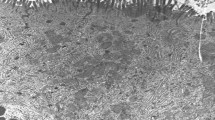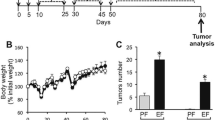Abstract
Purpose
Some epidemiological studies have shown an association between opium consumption and the incidence of gastrointestinal (GI) cancer. The present study was designed to investigate the effects of opium on the initiation of GI cancer in rats.
Methods
Forty-five rats were randomly divided into three groups; each received different treatment for 40 weeks. The rats in group 1 received purified water, while animals in group 2 were treated with 5 mg/kg diethylnitrosamine (DEN) orally for 8 weeks and continued with purified water by the end of the experiment. The third experimental group received 300 mg/kg opium for 16 weeks and then continued with 50 mg/kg phenobarbital by the end of the 40th week. The growth of tumors in the treated groups was assessed by histological changes and the up/down expression of p53, cdkn1, cdk2, e-cdh, and n-cdh genes in different parts of GI tract.
Results
Histological examinations revealed that DEN was able to induce the growth of tumor in GI tract as shown by active mitotic figure in different regions of GI system and hyperplasia of hepatocytes associated with infiltration of inflammatory cells, intestinal villous hypertrophy, and colorectal adenoma. There was also significant (p < 0.05) overexpression of p53, cdk2, and n-Cdh genes in different parts of digestive system in DEN-treated group. However, these pathological changes and the degradation of gene expression were not observed in the opium-treated group.
Conclusion
The results of this study suggest that the opium does not promote the initiation of cancer in GI tract.



Similar content being viewed by others
Change history
22 March 2018
The original version of this article unfortunately contained a mistake in the author group section. The correct name of the fourth author is “Reza Shirkoohi.”The original article has been corrected.
References
Sadjadi A, Nouraie M, Mohagheghi MA, Mousavi-Jarrahi A, Malekezadeh R, Parkin DM. Cancer occurrence in Iran in 2002, an international perspective. Asian Pac J Cancer Prev. 2005;6(3):359–63.
American Cancer Society. Cancer facts and figures. Atlanta, GA: Publisher American cancer Society. 2012. http://www.cancer.org/research/cancerfactfigures/cancer-facts-figure-2012:1-2.
Liao DJ, Blanck A, Eneroth P, Gustafsson JA, Hällström IP. Diethylnitrosamine causes pituitary damage, disturbs hormone levels, and reduces sexual dimorphism of certain liver functions in the rat. Environ Health Perspect. 2001;109(9):943–7. https://doi.org/10.1289/ehp.01109943.
Verna L, Whysner J, Williams GM. N-nitrosodiethylamine mechanistic data and risk assessment: bioactivation, DNA-adduct formation, mutagenicity, and tumor initiation. Pharmacol Ther. 1996;71(1):57–81. https://doi.org/10.1016/0163-7258(96)00062-9.
Aggrawal A. Opium: the king of narcotics. In: Aggrawal A, editor. Narcotic drugs. New Delhi: New Delhi National Book Trust; 1995. p. 161.
United Nations Office on Drugs and Crime (UNODC). World drug report 2010. United Nations Publication Sales No.10.XI.13; 2010:1–50.
Heydari M, Hashem Hashempur M, Zargaran A. Medicinal aspects of opium as described in Avicenna’s Canon of Medicine. Acta Medico-Historica Adriatica. 2013;11(1):101–12.
Shakeri R, Kamangar F, Nasrollahzadeh D, Nouraie M, Khademi H, Etemadi A, et al. Is opium a real risk factor for esophageal cancer or just a methodological artifact? Hospital and neighborhood controls in case-control studies. PLoS One. 2012;7(3):e32711. https://doi.org/10.1371/journal.pone.0032711.
Malekzadeh MM, Khademi H, Pourshams A, Etemadi A, Poustchi H, Bagheri M, et al. Opium use and risk of mortality from digestive diseases: a prospective cohort study. Am J Gastroenterol. 2013;108(11):1757–65. https://doi.org/10.1038/ajg.2013.336.
Shakeri R, Malekzadeh R, Etemadi A, Nasrollahzadeh D, Aghcheli K, Sotoudeh M, et al. Opium: an emerging risk factor for gastric adenocarcinoma. Int J Cancer. 2013;133(2):455–61. https://doi.org/10.1002/ijc.28018.
Mousavi MRA, Damghani MA, Haghdoust AA, Khamesipour A. Opium and risk of laryngeal cancer. Laryngoscope. 2003;113(11):1939–43.
Khademi H, Malekzadeh R, Pourshams A, Jafari E, Salahi R, Semnani S, et al. Opium use and mortality in Golestan Cohort Study: prospective cohort study of 50 000 adults in Iran. BMJ. 2012;344(apr17 2):e2502. https://doi.org/10.1136/bmj.e2502.
Hosseini SY, Safarinejad MR, Amini E, Hooshyar H. Opium consumption and risk of bladder cancer: a case-control analysis. In: Urologic Oncology: Seminars and Original Investigations. Elsevier; 2010. vol 6, p. 610–616.
Dillenburg CF, Kruel CDP, Cerski CT, Edelweiss MI, Schier AS. Morphine does no promote esophageal carcinogenesis in rats exposed to diethylnitrosamine. Arq Gastroenterol. 2008;45(1):87–92. https://doi.org/10.1590/S0004-28032008000100016.
Tegeder I, Grösch S, Schmidtko A, Häussler A, Schmidt H, Niederberger E, et al. G protein-independent G1 cell cycle block and apoptosis with morphine in adenocarcinoma cells. Cancer Res. 2003;63(8):1846–52.
Sasamura T, Nakamura S, Iida Y, Fujii H, Murata J, Saiki I, et al. Morphine analgesia suppresses tumor growth and metastasis in a mouse model of cancer pain produced by orthotopic tumor inoculation. Eur J Pharmacol. 2002;441(3):185–91. https://doi.org/10.1016/S0014-2999(02)01450-4.
Aneja R, Zhou J, Zhou B, Chandra R, Joshi HC. Treatment of hormone-refractory breast cancer: apoptosis and regression of human tumors implanted in mice. Mol Cancer Ther. 2006;5(9):2366–77. https://doi.org/10.1158/1535-7163.MCT-06-0205.
Jackson T, Chougule MB, Ichite N, Patlolla RR, Singh M. Antitumor activity of noscapine in human non-small cell lung cancer xenograft model. Cancer Chemother Pharmacol. 2008;63(1):117–26. https://doi.org/10.1007/s00280-008-0720-z.
Aneja R, Ghaleb AM, Zhou J, Yang VW, Joshi HC. p53 and p21 determine the sensitivity of noscapine-induced apoptosis in colon cancer cells. Cancer Res. 2008;67(8):3862–70.
Sajadian S, Vatankhah M, Majdzadeh M, Kouhsari SM, Ghahremani MH, Ostad SN. Cell cycle arrest and apoptogenic properties of opium alkaloids noscapine and papaverine on breast cancer stem cells. Toxicol Mech Methods. 2015;25(5):388–95. https://doi.org/10.3109/15376516.2015.1045656.
Hayes AW, Kruger CL. Hayes’ principles and methods of toxicology. Boca Raton: CRC Press; 2014.
Lijinsky W. Chemistry and biology of N-nitroso compounds. Cambridge: Cambridge University Press; 1992.
Sánchez-Pérez Y, Carrasco-Legleu C, García-Cuellar C, Pérez-Carreón J, Hernández-García S, Salcido-Neyoy M, et al. Oxidative stress in carcinogenesis. Correlation between lipid peroxidation and induction of preneoplastic lesions in rat hepatocarcinogenesis. Cancer Lett. 2005;217(1):25–32. https://doi.org/10.1016/j.canlet.2004.07.019.
Schmahl D. Combination effects in chemical carcinogenesis. In: Chambers PL, Klinger W, editors. Further studies in the assessment of toxic actions. Arch Toxicol Suppl. 1980;4:29–40.
Lijinsky W. Intestinal cancer induced by N-nitroso compounds. Toxicol Pathol. 1988;16(2):198–204. https://doi.org/10.1177/019262338801600212.
Kawanishi S, Hiraku Y, Murata M, Oikawa S. The role of metals in site-specific DNA damage with reference to carcinogenesis 1, 2. Free Radic Biol Med. 2002;32(9):822–32. https://doi.org/10.1016/S0891-5849(02)00779-7.
Valko M, Rhodes C, Moncol J, Izakovic M, Mazur M. Free radicals, metals and antioxidants in oxidative stress-induced cancer. Chem Biol Interact. 2006;160(1):1–40. https://doi.org/10.1016/j.cbi.2005.12.009.
Pawan M, Choudhary R, Mathur R, Choudhary M, Kamla M. Study on harmful effects of opium on liver and lungs in chronic opium addicts of western Rajasthan. Journal of Bangladesh Society of Physiologist. 2011;6(2):122–6.
Atici S, Cinel I, Cinel L, Doruk N, Eskandari G, Oral U. Liver and kidney toxicity in chronic use of opioids: an experimental long term treatment model. J Biosci. 2005;30(2):245–52. https://doi.org/10.1007/BF02703705.
Frenklakh L, Bhat RS, Bhaskaran M, Sharma S, Sharma M, Dinda A, et al. Morphine-induced degradation of the host defense barrier. Dig Dis Sci. 2006;51(2):318–25. https://doi.org/10.1007/s10620-006-3132-0.
Harari Y, Weisbrodt NW, Moody FG. The effect of morphine on mast cell–mediated mucosal permeability. Surgery. 2006;139(1):54–60. https://doi.org/10.1016/j.surg.2005.07.009.
Aylon Y, Oren M. New plays in the p53 theater. Curr Opin Genet Dev. 2011;21(1):86–92. https://doi.org/10.1016/j.gde.2010.10.002.
El-Deiry W. P21/P53, cellular growth control and genomic integrity. Cyclin Dependent Kinase (CDK) Inhibitors. In: Current Topics in Microbiology and Immunology book series. 1998;227:121–137.
Abbas T, Dutta A. p21 in cancer: intricate networks and multiple activities. Nat Rev Cancer. 2009;9(6):400–14. https://doi.org/10.1038/nrc2657.
Zhu W, Abbas T, Dutta A. DNA Replication and Genomic. Genomic Advances in Experimental Medicine and Biology book series. 2005; 249–279.
Pasz-Walczak G, Kordek R, Faflik M. P21 (WAF1) expression in colorectal cancer: correlation with P53 and cyclin D1 expression, clinicopathological parameters and prognosis. Pathology-Research and Practice. 2001;197(10):683–9. https://doi.org/10.1078/0344-0338-00146.
Sotillo R, Dubus P, Martn J, de la Cueva E, Ortega S, Malumbres M, et al. Wide spectrum of tumors in knock-in mice carrying a Cdk4 protein insensitive to INK4 inhibitors. EMBO J. 2001;20(23):6637–47. https://doi.org/10.1093/emboj/20.23.6637.
Doak S, Jenkins G, Parry E, Griffiths A, Shah V, Baxter J, et al. Characterisation of p53 status at the gene, chromosomal and protein levels in oesophageal adenocarcinoma. Br J Cancer. 2003;89(9):1729–35. https://doi.org/10.1038/sj.bjc.6601323.
Acknowledgements
We would like to thank the Ministry of Higher Education and Scientific Research in Iraq and the University of Tehran for funding this study. Special thanks to Dr. Hossein Golami and Dr. Hassan Khalaf Al-Qaraghouli for preparation of some pathological pictures of tissues.
Author information
Authors and Affiliations
Corresponding author
Ethics declarations
The experimental protocol has been approved by the institutional Animal care and use Committee.
Conflict of Interest
The authors declare that they have no conflict of interest.
Additional information
The original version of this article was revised: The original version of this article unfortunately contained a mistake in the author group section. The correct name of the fourth author is “Reza Shirkoohi.”
Rights and permissions
About this article
Cite this article
Alzaidi, M.A., Arab, H.A., Amanpour, S. et al. Opium Consumption and the Incidence of Cancer: Does Opium Account as an Emerging Risk Factor for Gastrointestinal Cancer?. J Gastrointest Canc 49, 172–180 (2018). https://doi.org/10.1007/s12029-017-0050-7
Published:
Issue Date:
DOI: https://doi.org/10.1007/s12029-017-0050-7




